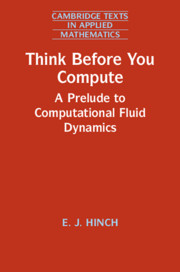Refine search
Actions for selected content:
8126 results in Fluid dynamics and solid mechanics
15 - Nonlinear considerations
- from Part III - Special Topics
-
- Book:
- Think Before You Compute
- Published online:
- 28 April 2020
- Print publication:
- 30 April 2020, pp 190-196
-
- Chapter
- Export citation
Contents
-
- Book:
- Think Before You Compute
- Published online:
- 28 April 2020
- Print publication:
- 30 April 2020, pp v-x
-
- Chapter
- Export citation
9 - Software packages and FreeFem++
- from Part III - Special Topics
-
- Book:
- Think Before You Compute
- Published online:
- 28 April 2020
- Print publication:
- 30 April 2020, pp 127-135
-
- Chapter
- Export citation
6 - Spectral methods
- from Part II - Generalities
-
- Book:
- Think Before You Compute
- Published online:
- 28 April 2020
- Print publication:
- 30 April 2020, pp 86-99
-
- Chapter
- Export citation
Part II - Generalities
-
- Book:
- Think Before You Compute
- Published online:
- 28 April 2020
- Print publication:
- 30 April 2020, pp 51-52
-
- Chapter
- Export citation
17 - Wavelets
- from Part III - Special Topics
-
- Book:
- Think Before You Compute
- Published online:
- 28 April 2020
- Print publication:
- 30 April 2020, pp 217-225
-
- Chapter
- Export citation
13 - Fast Poisson solvers
- from Part III - Special Topics
-
- Book:
- Think Before You Compute
- Published online:
- 28 April 2020
- Print publication:
- 30 April 2020, pp 175-182
-
- Chapter
- Export citation
8 - Linear algebra
- from Part II - Generalities
-
- Book:
- Think Before You Compute
- Published online:
- 28 April 2020
- Print publication:
- 30 April 2020, pp 110-124
-
- Chapter
- Export citation
Part III - Special Topics
-
- Book:
- Think Before You Compute
- Published online:
- 28 April 2020
- Print publication:
- 30 April 2020, pp 125-126
-
- Chapter
- Export citation
3 - Primitive variable formulation
- from Part I - A First Problem
-
- Book:
- Think Before You Compute
- Published online:
- 28 April 2020
- Print publication:
- 30 April 2020, pp 35-50
-
- Chapter
- Export citation
Frontmatter
-
- Book:
- Think Before You Compute
- Published online:
- 28 April 2020
- Print publication:
- 30 April 2020, pp i-iv
-
- Chapter
- Export citation
10 - Hyperbolic equations
- from Part III - Special Topics
-
- Book:
- Think Before You Compute
- Published online:
- 28 April 2020
- Print publication:
- 30 April 2020, pp 136-155
-
- Chapter
- Export citation
16 - Particle methods
- from Part III - Special Topics
-
- Book:
- Think Before You Compute
- Published online:
- 28 April 2020
- Print publication:
- 30 April 2020, pp 197-216
-
- Chapter
- Export citation
5 - Finite elements
- from Part II - Generalities
-
- Book:
- Think Before You Compute
- Published online:
- 28 April 2020
- Print publication:
- 30 April 2020, pp 64-85
-
- Chapter
- Export citation
14 - Fast Multipole Method
- from Part III - Special Topics
-
- Book:
- Think Before You Compute
- Published online:
- 28 April 2020
- Print publication:
- 30 April 2020, pp 183-189
-
- Chapter
- Export citation
Index
-
- Book:
- Think Before You Compute
- Published online:
- 28 April 2020
- Print publication:
- 30 April 2020, pp 226-228
-
- Chapter
- Export citation

Think Before You Compute
- A Prelude to Computational Fluid Dynamics
-
- Published online:
- 28 April 2020
- Print publication:
- 30 April 2020
ANZ VOLUME 61 ISSUE 4 COVER AND BACK MATTER
-
- Journal:
- The ANZIAM Journal / Volume 61 / Issue 4 / October 2019
- Published online by Cambridge University Press:
- 24 April 2020, pp. b1-b9
-
- Article
-
- You have access
- Export citation
ANZ VOLUME 61 ISSUE 4 COVER AND FRONT MATTER
-
- Journal:
- The ANZIAM Journal / Volume 61 / Issue 4 / October 2019
- Published online by Cambridge University Press:
- 24 April 2020, pp. f1-f2
-
- Article
-
- You have access
- Export citation
THE ALTERNATIVE KIRCHHOFF APPROXIMATION IN ELASTODYNAMICS WITH APPLICATIONS IN ULTRASONIC NONDESTRUCTIVE TESTING
- Part of
-
- Journal:
- The ANZIAM Journal / Volume 62 / Issue 4 / October 2020
- Published online by Cambridge University Press:
- 23 April 2020, pp. 406-422
-
- Article
-
- You have access
- Export citation
